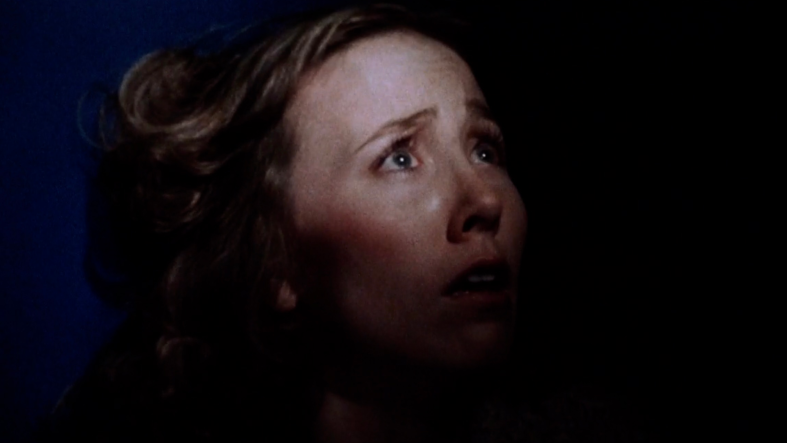‘The Dorm That Dripped Blood’ Is a Lot Like ‘Black Christmas’ (In a Good Way)

More than most holiday horror outings, there’s something about the Christmas season that inspires unkempt cruelty and nihilism from filmmakers. Calvaire, Inside, and Krampus—among several others—subvert festive, jolly tradition, and punish their characters like terrifying tinsel, decking the halls with entrails and garlands of gore. Of course, the greatest among them is Bob Clark’s Black Christmas. Five decades and two remakes later, Clark’s savage, matter-of-fact slasher remains the apotheosis of not just Christmas horror movies, but slashers in general. Black Christmas inspired everything from John Carpenter’s Halloween to Sean S. Cunningham’s Friday the 13th, not to mention sundry other masked maniac gore fests since then. Yet, its closest thematic brethren might well not be any of those. Instead, I’d argue it’s Stephen Carpenter and Jeffrey Obrow’s 1982 lo-fi shocker The Dorm That Dripped Blood.
Originally titled “Pranks,” The Dorm That Dripped Blood was Carpenter and Obrow’s attempt at capitalizing on the burgeoning slasher trend. The 1980s were a remarkable year for the subgenre, and while it is too easily dismissed as formulaic, plenty of releases at the time were endeavoring to do something new, to say something amidst the bloodshed. Titles like 1982’s The Slayer or 1988’s Out of the Dark were grisly, inspired slasher movies, culling from the best while solidifying an identity, and artistry, all their own.
Also Read: Gale Weathers’ Ghostface Call is One of 2023’s Best Scenes
Christmas slasher The Dorm That Dripped Blood is no different. While it endures today on account of a Randy Meeks monologue and a curious IMDB profile—it was Daphne Zuniga’s film debut—the $150,000 production is considerably better than its modest means suggest. Familiarity might breed contempt here, though, as awareness of the structure gamely augments the tension and terror to come. After an opening kill—soon to be convention—a young group of co-eds stay behind during the Christmas break to help prepare a condemned dormitory for demolition. Why? Who cares, that’s why.
Of course, there is a killer among their ranks. One by one, the assortment of handsome young adults wander off to be killed until one final girl remains. In this case, that’s Laurie Lapinski’s Joanne, following the soon-to-be-established final girl beats to a tee. She is menaced, chased, knocked unconscious, and regularly dubious of who the killer might be. The Dorm That Dripped Blood unwraps the slasher coda, delivering what audiences would come to expect with aplomb.
It features one of the most sensational chase scenes in the subgenre, and notably, it ends on a grim note, the equivalent of a rotten panettone for breakfast. The police mistakenly kills the wrong man, allowing the killer to escape and dump final girl Joanne’s body into an incinerator. Outside, the police wonder what the noxious smell escaping from the vents might be.
Also Read: This Free-to-Stream Holiday Horror Flick is an Underrated Christmas Treat
So, while The Dorm That Dripped Blood follows the rhythms of the subgenre, it does so with more confidence than many of its ilk while also delineating a clear throughline between it and Black Christmas. The similarities are remarkable, and while Black Christmas is and likely will remain the superior offering, it’s incredible to see just how close The Dorm That Dripped Blood at times comes to matching its yuletide nihilism.
For starters, there is a lovesick subplot, with The Dorm That Dripped Blood’s killer targeting his friends on account of an unrequited romance with Joanna. While Black Christmas’ Peter (Keir Dullea) isn’t the killer (though some fan theories suggest he is), both films highlight the predatory nature of some men and their ostensibly innocent crushes. I highlighted the gnawing menace in my Cat Person review earlier this year; sometimes not liking someone back is the most dangerous thing a person, especially a woman, could do.
So, kudos to The Dorm That Dripped Blood’s undercurrent of social commentary, however shallow it might be. The lovesick killer isn’t exactly new, but the low-budget swagger of Dorm’s stalk-and-slash sequences, like Black Christmas, renders it considerably more realistic than the subgenre’s later digitally polished (and more expensive) offerings.
And, of course, we have to talk about that ending. Infamously, Black Christmas ends with Olivia Hussey’s Jess in bed recovering as the police transport bodies from the sorority house. The camera pans out, revealing Clare Harrison’s (Lynne Griffin) body still rocking in the attic—no one has found her yet. Notably, the film’s killer only calls after he’s killed someone. Perceptive audiences can spot a shadow descending from the attic before the phone rings one final time, suggesting—if you’re a pessimist like me—that Jess has been killed.
Also Read: The Best Horror Kills of 2023
Similarly, some absolutely useless law enforcement is what ultimately does Dorm’s Joanne in. The police kill the person trying to save her, mistaking him for the killer. Then, incredulously (though if you know law enforcement, not so incredulously) they leave her with the killer while they shuttle out to gather reinforcements. It was, in fairness, a bloodbath. Still, their negligent oversight gives the killer enough time to dump Joanne into the aforementioned incinerator while the police stand doe-eyed about.
Both Black Christmas and The Dorm That Dripped Blood grimly subvert festive traditions. For some, the holiday season is a merciless cesspool of suffering, regret, guilt, and grief. Both films adroitly reflect a Christmas season more akin—however exaggerated—to what many likely know year after year. The Dorm That Dripped Blood isn’t Black Christmas, but it’s a loving homage to one of the greatest there ever was. Before the year comes to a close, consider a fireside double-feature. You won’t regret it.
Categorized:Editorials

